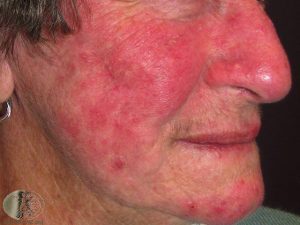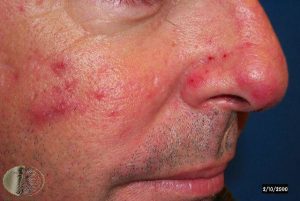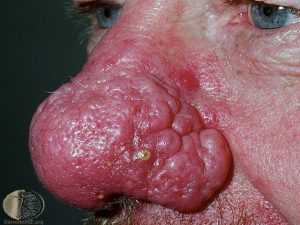
Rosacea is a common skin disease that is typically characterized by redness on the nose and cheeks, sometimes on the forehead and chin. Sometimes the redness is constant, other times it is more from flushing. Some forms of this skin disease cause red bumps in the affected areas, and there can also be eye redness and irritation. Most people with rosacea are fair skinned and between 30 and 50 years of age. Women are more likely than men to have this disease, except for the phymatous type that often affects the nose. There are 4 subtypes of rosacea:
- Erythematotelangiectatic: most common type; persistent redness
- Papulopustular: red acne-like bumps
- Phymatous: Thickening of the skin of the nose, chin, forehead, cheeks
- Ocular: Gritty sensation in the eyes with redness and sensitivity

Rosacea is caused by dysregulation of certain parts of the immune system in the skin, which leads to inflammation. Sometimes this inflammation is driven by a mite that lives in pores of the skin called demodex and sometimes by a bacterium that lives on this mite. Some treatments target demodex and its associated bacteria.

Treating rosacea is often multifactorial due to the different symptoms associated with the disease and different reasons for each symptom. First, it is important to identify and avoid triggers, such as spicy foods, sunlight, or cold dry wind. Sun protection with broad spectrum mineral sunscreen SPF 30 or higher is recommended, as well as avoidance of mid-day sun between 10 am and 4 pm, seeking shade, and wearing a broad-brimmed hat. It is important to use gentle face cleansers and to not scrub aggressively. A mild moisturizer is important every day. Some topical or oral medications may be prescribed by your dermatologist to address red bumps associated with the disease. There is a new type of topical prescription cream to help reduce persistent daily redness on the face. Cosmetic treatments may be required to address visible blood vessels or texture changes that result from long standing disease.
